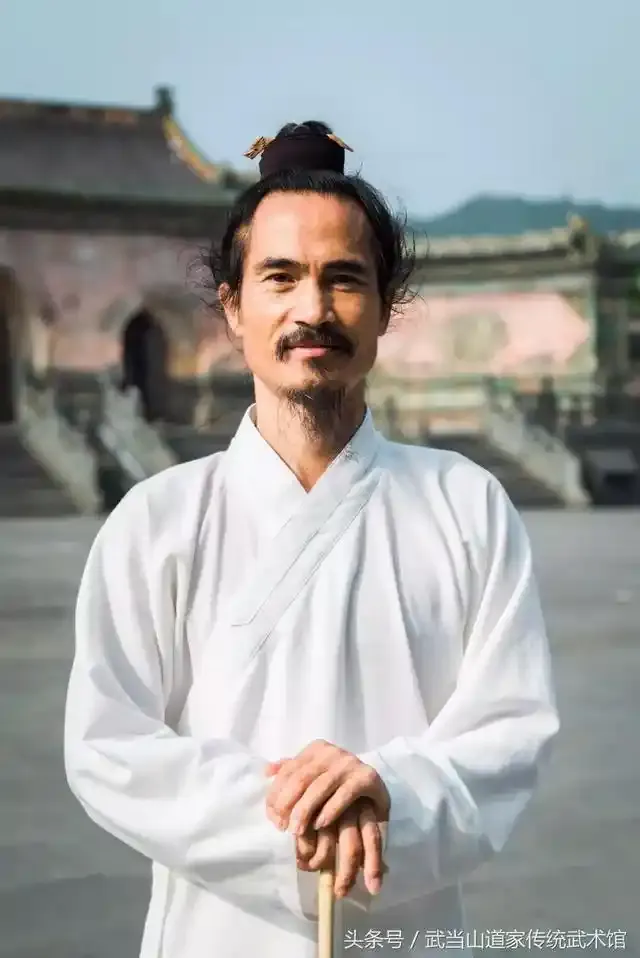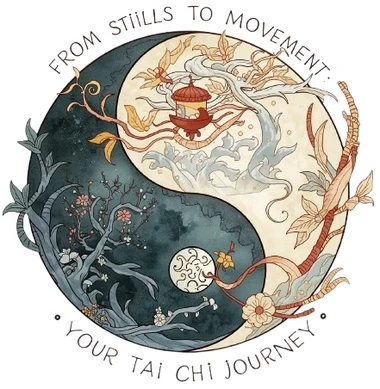Let's be honest. In a world of endless notifications and digital distractions, finding deep focus can feel like a superpower you just weren't born with.
You've tried the apps, the timers, the productivity hacks. But what if the secret to a calmer, sharper mind isn't about fighting for focus, but about cultivating it through a systematic, time-tested practice?
The solution lies in Tai Chi. This isn't just slow-motion exercise; it's a powerful form of moving meditation that directly trains your brain for focus by systematically improving your body's core operating systems: your nervous system, musculoskeletal structure, and even your cellular health.
Forget the mystical jargon. We're breaking down exactly how the medical principles behind Tai Chi's four pillars—breath training, muscle balance, joint protection, and anti-aging—work together to build an unshakable foundation for your concentration.

How Does Tai Chi's Breathing Technique Rewire Your Nervous System for Calm?
Think of your nervous system as a seesaw. On one end is your "fight-or-flight" mode (sympathetic nervous system), and on the other is your "rest-and-digest" mode (parasympathetic). Modern life has that seesaw stuck on "fight-or-flight."
Tai Chi uses a specific technique called reverse abdominal breathing to tip the balance back. Here’s how it works:
- Inhale: Gently draw your belly button inward.
- Exhale: Expand your abdomen fully.
This isn't just "deep breathing." This action stimulates your vagus nerve, the command center for your "rest-and-digest" system. The result?
- Cortisol (your main stress hormone) drops.
- Your heart rate slows.
- The mental static of anxiety quietens.
Why it matters for focus: A stressed brain is a scattered brain. By manually activating your calm-down system, you create the neurochemical quiet necessary for deep concentration. It’s like hitting the "mute" button on your internal chaos.
Can Better Posture Really Improve Your Concentration?
Absolutely. Your brain and body are not separate.
If you're constantly compensating for a slouched posture or a tight lower back, your brain is expending precious energy on managing that discomfort. Tai Chi builds what’s known as "relaxed strength."
Through foundational stances and movements, you train your core stabilizers and postural muscles to work in perfect harmony. This isn't about getting a six-pack; it's about building an efficient, balanced frame.
- Corrects muscle imbalances from sitting all day.
- Optimizes biomechanics so movement becomes effortless.
- Reduces physical "noise" like back pain and stiffness.
The Focus Connection: When your body is stable and pain-free, it stops sending "help!" signals to your brain. This frees up massive cognitive resources, allowing you to direct 100% of your attention to the task at hand. A balanced body is a stable platform for a focused mind.
The Listicle: Your 3-Step Tai Chi Breathing Reset
Need a quick focus boost right now? Try this:
- Find Your Seat: Sit upright, feet flat on the floor.
- The Breath Cycle: Place a hand on your belly. Inhale slowly through your nose for 4 counts, feeling your abdomen expand. Exhale slowly for 6 counts, feeling your abdomen contract.
- Anchor Your Mind: As you breathe, focus solely on the sensation of your hand rising and falling. When your mind wanders (it will!), gently guide it back.
Do this for just 2 minutes. Feel calmer? That's your parasympathetic nervous system kicking in.
Guide you through the reverse abdominal breathing technique step-by-step

What's the Link Between Protecting Your Joints and Protecting Your Attention?
It’s simple: you can’t focus if you’re in pain.
Tai Chi is famous for its joint-protecting benefits, especially for knees and hips. The slow, controlled, weight-bearing motions are like oiling a rusty hinge.
- They stimulate synovial fluid production, which nourishes joint cartilage.
- They strengthen the surrounding ligaments and tendons without impact.
- They maintain a full range of motion.
By preserving joint health and preventing the distraction of chronic pain, Tai Chi removes a major barrier to sustained mental focus. It allows you to sit, stand, and move comfortably, so your mind isn't constantly pulled away by physical complaints.
The Surprising Anti-Aging Effect on Your Brain Cells
This is where it gets really exciting. Research from Harvard University found that consistent Tai Chi practice can actually increase telomerase activity.
What are telomeres? Think of them as the protective plastic caps on the ends of your shoelaces. As your cells divide and age, these "caps" (telomeres) get shorter. Once they're too short, the cell can no longer function properly. Telomerase is the enzyme that helps maintain these caps.
Harvard Study Insight: “Six months of Tai Chi practice significantly boosted telomerase activity, suggesting a potential slowing of the cellular aging process.”
This isn't just about living longer; it's about thinking sharper for longer. By combating cellular aging, Tai Chi helps preserve the very hardware your focus runs on.
In the next section, we'll tie it all together and show you how the "spirit-nourishing" function directly translates into real-world focus, with a simple plan to get started.
How Does "Moving Meditation" Forge a More Focused Brain?
So, we've seen how Tai Chi tunes up your body—calming your nerves, balancing your muscles, and protecting your joints. But how do these physical benefits literally build a better brain for focus?
The magic happens in the practice of "Yi Yian Tao," or "using intention to lead the movement." This isn't just going through the motions. It’s the active, conscious directing of your attention to every micro-movement. You're not just moving your hand; you're feeling the energy shift, you're visualizing the flow.
This is the ultimate focus workout. You're constantly bringing a wandering mind back to a single, physical point of reference.
Think of it like this: Your focus is a muscle. Every time you gently guide your attention back to your movement and breath, you're doing a rep for your prefrontal cortex—the brain's CEO for attention.
The Neurochemical Payoff: A Better Brain State for Work and Life
What does this "focus workout" actually do inside your skull? The science is clear:
- Lowers Cortisol: High cortisol = brain fog. By reducing this stress hormone, Tai Chi clears the mental static.
- Boosts Blood Flow: The gentle movements increase circulation, delivering more oxygen and glucose to your brain—its primary fuel.
- Enhances Neuroplasticity: This is a big one. Your brain's ability to rewire itself is called neuroplasticity. The complex coordination of Tai Chi forces your brain to create new connections, keeping it agile and sharp.
The result? You're not just calmer. You're cognitively sharper. You can switch tasks more efficiently, filter out distractions better, and sustain your attention on that big project without needing to check your phone every five minutes.
Your No-Excuses Guide to Starting Tai Chi
Intrigued but think you don't have the time or grace for it? Let's bust those myths right now.
Myth #1: "I'm not coordinated enough."
Truth: Tai Chi is the antidote to poor coordination. It builds it from the ground up, step by tiny step. Everyone starts somewhere.
Myth #2: "I don't have 90 minutes to spare."
Truth: Who does? Even 10-15 minutes a day can trigger the parasympathetic nervous system and start training your focus. Consistency beats duration.
The 3-Step "Get Started" Plan
Ready to give it a try? Here's how to dip your toes in without overwhelm.
Find Your "Why": Are you doing it for stress relief? Better focus? Joint health? Naming your goal will keep you motivated.
Learn ONE Thing: Don't try to learn a whole form. Start with "The Rising and Falling Stance."
Stand with feet shoulder-width apart.
Slowly rise onto your toes, then slowly lower back down.
That's it. Focus on your balance and your breath for 2-3 minutes.
Pair it with a Habit: Do your 2-minute stance while waiting for your coffee to brew. Habit stacking makes it stick.

It's System Reset, Not Just Exercise
Tai Chi isn't a quick fix. It's a systematic upgrade to your mind-body operating system.
By synergizing breath work, postural alignment, joint health, and cellular rejuvenation, it doesn't just help you focus. It builds the fundamental physiological environment where focus can thrive naturally.
You're not fighting your distracted mind. You're giving it a better, calmer, and stronger home to live in.
Your move. Take one tiny step. Try that 2-minute breathing reset. Or that simple rising/falling stance. See for yourself how an ancient practice can be the most modern solution to your focus struggles.
The 5-Minute Tai Chi "Flow State" Primer
Think you need to learn a 108-move form to get benefits? Think again. True Tai Chi is about principles, not perfect choreography. Here's how to capture its essence in just five minutes.
Your Micro-Practice:
- Grounding (1 minute): Stand with feet shoulder-width apart, knees slightly bent. Close your eyes. Feel your feet connecting to the floor. Breathe naturally.
- Centering (2 minutes): Place your hands on your lower abdomen (your "Dantian"). Practice reverse abdominal breathing here. 5 slow breaths: expand on exhale, contract on inhale.
- Flowing (2 minutes): Open your eyes. Practice "Cloud Hands" slowly:
Shift weight to your left foot, raising the right toes.
As you shift right, let your left hand float up as if tracing a large ball.
Keep it continuous, slow, and connected to your breath.
Pro Tip: Do this as a morning ritual before checking your phone. You're not just stretching—you're setting a calm, focused tone for your entire day.
The Science of Slowness: Why Moving Slowly Makes Your Brain Faster
It seems counterintuitive, right? How can slowing your body possibly speed up your mind?
Here's the secret: Slowness exposes inefficiency. When you move fast, your body can cheat with momentum and jerkiness. But when you move with Tai Chi's deliberate slowness, every tiny muscular imbalance and mental distraction becomes glaringly obvious.
- It forces micro-adjustments in your stabilizer muscles you never knew you had.
- It trains proprioception—your brain's 3D map of your body in space.
- It builds deep patience, directly transferring to your ability to stay with a difficult task.
A 2019 study in the Journal of Cognitive Enhancement found that participants who practiced slow, mindful movement showed significant improvements in sustained attention tests compared to a brisk walking group.
Real People, Real Results: Beyond the Lab
Forget abstract concepts. Here’s what this looks like in daily life:
- Sarah, 42, Project Manager: "After 3 months of 15-minute morning sessions, I stopped multitasking by default. I now listen in meetings without mentally drafting emails. My team says I'm more present."
- David, 58, Programmer: "The 'awareness' from practice spilled over. I notice tension in my shoulders the second it starts while coding, and I can breathe through it. That's less pain, and fewer broken trains of thought."
Their secret? They treated Tai Chi as mental training that uses the body, not just exercise.
Your Next Step is Simpler Than You Think
You now hold the blueprint. Tai Chi's power for focus isn't a mystery—it's a reproducible system.
- It resets your nervous system through targeted breathing.
- It optimizes your physical structure so your body doesn't drain your brain.
- It protects the hardware (your joints and cells) your mind runs on.
- It directly trains your attention muscle through moving meditation.
Practice this breathing rhythm with our online breath coach. You don't need a special outfit, a huge time commitment, or any prior skill. You just need the willingness to try one small thing.
Challenge for you today: Before your next big task, take just 90 seconds. Do the "Centering" step from the 5-minute primer. Then, begin your work. Feel the difference?
That's the power of a practiced mind. The rest is just repetition.
Ready to go deeper? Explore our beginner-friendly online classes or find a certified instructor in your area. Your focus doesn't have to be a casualty of modern life—it can be your greatest strength.
Your Tai Chi Questions, Answered
I'm a complete beginner with poor flexibility. Can I still benefit from Tai Chi?
Absolutely. Think of Tai Chi as "movement kindergarten" – it meets you exactly where you are. You don't need flexibility to start; you develop it through the practice itself. The slow, controlled motions gently increase your range of motion over time, making it one of the most accessible mind-body practices for all fitness levels. The focus is on proper body alignment and mindful movement, not on touching your toes.
How does Tai Chi specifically protect joints and aid pain management?
It acts like "physical therapy in motion." Unlike high-impact exercises that pound your joints, Tai Chi uses slow, weighted movements to strengthen the supporting muscles around key joints like knees and hips. This creates a natural, muscular "scaffolding" that stabilizes the joint. The improved circulation also helps flush out inflammation and nourish cartilage. For many, it leads to a significant reduction in chronic pain, particularly in the lower back.
I need to improve my balance and prevent falls. Is Tai Chi proven to help?
Yes, it's one of the most evidence-based tools for fall prevention and stability training. The constant, subtle weight shifting teaches your body to maintain equilibrium from the inside out. You're not just learning to stand on one leg; you're reprogramming your neuromuscular system to react more efficiently if you start to trip, which is crucial for healthy aging and functional independence.
What are the proven anti-aging benefits for the brain?
The benefits go far beyond just feeling calm. Research, including studies from Harvard, points to two major cognitive enhancements and neuroprotective effects: It can slow cellular aging by protecting telomeres. It builds cognitive reserve by demanding coordinated focus, which enhances memory retention and mental clarity. It's like a full-system update for your brain's hardware and software.
Can Tai Chi's breathing techniques really help with anxiety and stress relief?
Without a doubt. This is often the first benefit people notice. The diaphragmatic breathing style directly stimulates your vagus nerve, switching your body from "fight-or-flight" to "rest-and-digest" mode. This triggers a physiological relaxation response, lowering your heart rate and calming your nervous system. It's a portable stress-management tool you can use anywhere, anytime you feel overwhelmed.
How does Tai Chi compare to other forms of exercise like yoga or cardio for overall wellness?
It's not an "either/or" but a powerful "and." Here’s the breakdown: vs. Cardio (Running, Cycling): Cardio is great for cardiovascular health and calorie burn. Tai Chi complements it by adding a deep layer of joint stability, balance, and nervous system regulation that high-impact cardio often neglects. vs. Yoga: Both are superb for mind-body connection. Yoga often focuses on static holds and deep stretching (flexibility). Tai Chi emphasizes continuous, flowing kinetic chain integration and dynamic balance, making it exceptional for real-world functional movement.
I've heard it's "moving meditation." What does that mean for my daily focus?
It means you're training focus in a dynamic, real-world context. Seated meditation is like practicing scales on a piano. Tai Chi is like playing a song—it requires you to maintain a calm, focused mind while your body is in motion. This skill directly translates to being able to concentrate on a work project while the office is buzzing around you.
